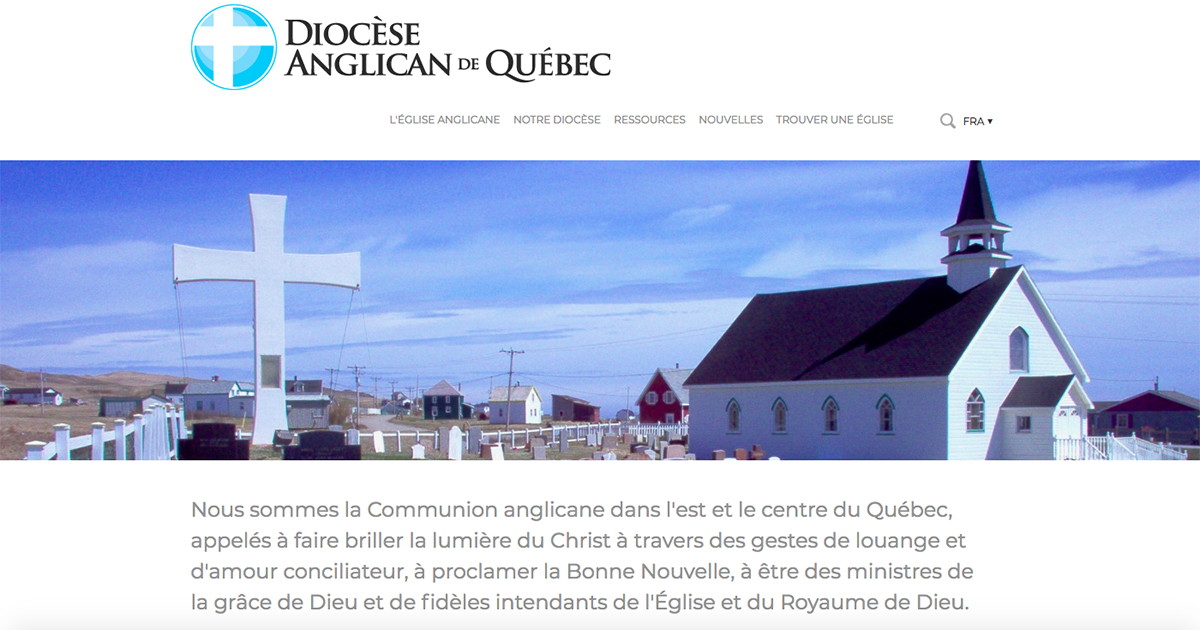An informal lunch meeting during the Road to Warm Springs National Church Gathering in Pinawa, Manitoba, has paved the way for a web development partnership model between the General Synod’s Communications Department and Anglican dioceses across Canada.
Bishop Bruce Myers of Quebec was chatting with Meghan Kilty, Director of Communications and Information Resources for the Anglican Church of Canada, when the conversation turned to the unsatisfactory nature of his diocese’s official website.
The website needed an update—badly. In addition, most of its content was available only in English—a disservice to the francophone community that the diocese is rooted in. However, the diocese’s limited resources made it difficult to implement the necessary changes.
“We’re a small diocese in terms of numbers and resources, and are always looking for a helping hand for projects like this,” Bishop Myers said.
Could the General Synod lend a hand?
According to Kilty, the General Synod’s Communications Department is ready to work with any diocese that needs support in improving its online presence.
“We developed a model in which we can help a diocese develop a website, and we can hand it off at the end of that development,” Kilty said. While the diocese “holds the keys” to its website, covering necessary costs and providing content, the General Synod can offer the time and expertise of its communications team to help develop the site, ensure optimal design and execution, and provide training for the diocese to update it effectively.
That model, she added, “is repeatable for any diocese that is seeking help to develop a site that is clean and modern—that’s mobile-friendly and meets all professional standards—up and running.”
Creation and development
Myers soon began working with the General Synod’s National Web Manager, Brian Bukowski, ushering in an exciting and new partnership between the General Synod’s Communications Team and Anglican Dioceses across Canada.
Bukowski worked closely with Bishop Myers on the design and structure of the new website. He also helped move content from the old website to the new one. It was important for the new website to have a platform that could accommodate at least three languages: English, French, and Naskapi – the language spoken by Indigenous people in the region. In order to do this, Bukowski looked at a number of multilingual plugin platforms before suggesting Voog, a tool that can provide easy toggling between languages, while also being able to accommodate syllabic characters.
While the vendor provides the first level of web support to dioceses, the General Synod’s Communications team can provide a secondary level of support in the event that dioceses wish to add new sections to the website.
“It’s a site that is hosted with the vendor, versus one where [the diocese has] to own a posting space and put the application on and manage the databases and everything,” Bukowski said. “Someone else is handling all that—the company—and it’s developing the system.”
Enhanced web presence
Feedback on the new website has been overwhelmingly positive; in particular, over the new French content.
“There was a sense that finally, there’s an almost fully bilingual web presence for the Anglican Church in this part of Quebec,” Myers said.
“Even if the majority of Anglicans in the diocese we serve are Anglophone, all of our neighbours and the air we breathe and the waters in which we swim are French-speaking. If we’re going to have any kind of meaningful public face and relationship with the dominant culture in which we exist, it needs to be in French. That’s one of the huge steps forward with our diocese’s web presence thanks to this new website.”
Moving forward, Myers hopes to continue expanding the website, with all online content ultimately being available in English, French, and Naskapi.
“Having a website these days is as basic as having a phone number was … 20, 30 years ago,” Bishop Myers said.
“It’s as basic as having a sign outside your church. The first place people go looking for information about your church is the Internet. They’re going to hit a search engine and go looking for you. So we’re glad that when people go into a search engine and look for ‘Anglican Church Quebec’, hopefully the first hit they’re going to get is our Diocesan website.”
New partnerships emerge
Weeks before the new website for the Diocese of Quebec had gone live, news of this initiative was already spreading across other areas of the Church. Bishop Lydia Mamakwa of the Indigenous Spiritual Ministry of Mishamikoweesh in Northern Manitoba and Ontario, reached out to Kilty and had begun consulting with Bukowski on how to develop a site for her ministry area.
Although approval is still pending for the new site, the website for the Spiritual Ministry of Mishamikoweesh will be very similar to that of the Diocese of Quebec. Both dioceses will take advantage of multilingual platforms—in this case, one for supporting content in both English and Oji-Cree.
“I think this is really an interesting model in the sense that we’re always here for [the diocese],” Bukowski said. “If they get into a pickle or if they can’t figure out something, or if they need to bring someone else on to do training, we’re here for them and we can get them off the ground.”
Dioceses interested in working with General Synod to develop or update a website are invited to contact Brian Bukowski at [email protected].
Interested in keeping up-to-date on news, opinion, events and resources from the Anglican Church of Canada? Sign up for our email alerts .

